- Zola vs The Knot: Which Registry is Better Today? - December 8, 2023
- Zola vs Amazon Registry: Which Has the Edge in 2024? - November 30, 2023
- Angara vs Blue Nile: I Like Both, for Different Purchases - May 26, 2023
It comes as no surprise that the princess cut is dubbed the second most popular cut in the world. The princess cut wedding ring combined the classic appeal of the square cut with the multi-faceted brilliance of the brilliant round cut to create a timeless statement cut.
If you are considering a Princess cut stone, it is essential to be well informed of the pros and cons that come with the cut, the most suitable GIA grades for the cut, and the most sensical settings for the cut. This article will walk you through the in’s and outs, as well as the in between, of the Princess cut.
Created as recent at the 1960’s, it’s not surprising that the Princess cut gained its popularity as rapidly as it did. Much like the round cut, the Princess cut focuses on maximizing the brilliance of stone while being more affordable than its Brilliant Round cut competitor – this affordability is a result of the cut itself retaining approximately 80% of the rough diamond, making it a favorite among diamond cutters and jewelers alike.
The princess cut is multi-faceted, typically containing anywhere between 54 and 144 facets. The amount of facets on the princess cut will depend on the shape of the face, that is, whether it’s more square or rectangle. Typically, a princess cut with under 50 facets is extremely undesirable as it does not properly allow the light to work through the diamond.
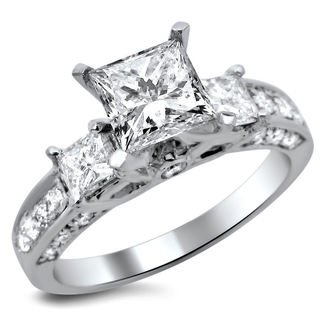
What Are the Pros of the Princess Cut Wedding Ring?
The Princess cut is extremely forgiving of any imperfections in the diamond. The cut itself camouflages imperfections in the diamond allowing the budget savvy couple the leeway to buy a more financially friendly still me.
The princess cut is also extremely versatile in that it looks good with small and large carat sizes and is complimentary of a majority of styles, while simultaneously getting the job done when alone in a solitaire.
For a budget savvy or unique bride and groom, this cut looks phenomenal with a majority of gemstones – we recommend a lighter shaded gem like the aquamarine, which will capture all the brilliance this cut can add, but the Princess cut will work with them all!
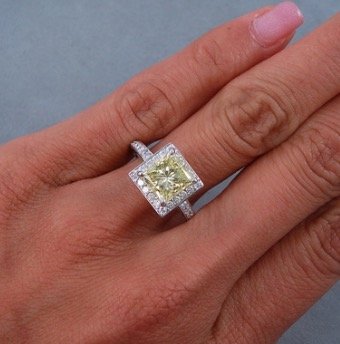
And the Cons?
Due to its shape, the princess cut has extremely delicate corners which are susceptible to chipping. Luckily this is easily combated through proper setting where the prongs wrap around the corners and shield them from obstructive contact.
Damage to the corners can also be avoided by chamfering the corners. A chamfered princess cut stone retains its square shape but it’s corners are rounded out, protecting the stone itself from chipping, snagging or being pulled out of its setting.
Clarity
The Gemological Institute of America (GIA) has created an international diamond rating system that allows for a universal standard for determining a diamonds quality. An aspect of this quality is the diamonds clarity. A diamonds clarity is determined by its number of inclusions and/blemishes. All diamond will have some inclusions and blemishes, but a flawless diamond will be one where they can’t be seen when magnified by ten.
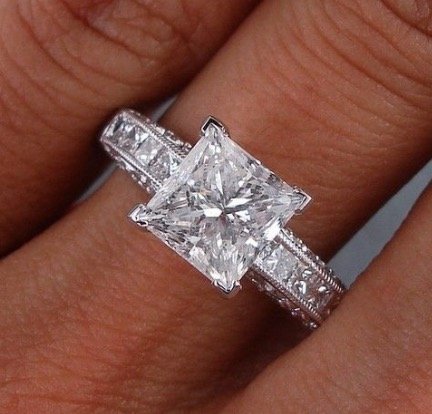
This list contains the clarity ratings as they determine the value of a diamond from the most expensive to the least:
Flawless (Fl) – No Inclusions.
Internally Flawless – (IF) No inclusions, only blemishes.
Very Very Slightly Included – (VVS1 and VVS2) Contains inclusions but they are very difficult to see.
Slightly included (SI1 and SI2) – Noticeably included.
Included (I1, I2, I3) – Obviously included.
An ideal diamond for a Princess cut will be anything from VVS1 and up. Avoid Princess cuts diamonds that fall into the categories of SI1, SI2, I1, I2 and I3.
Color
The GIA also grades diamonds on their color – or rather, lack of. This rating system does not include colored diamonds. Essentially, the ideal diamond is colorless while the least desirable is light yellow or brown.
These changes in color are extremely subtle, and may not even be noticeable to the naked eye, but they make a colossal impact on the price of a diamond so they are important.
This list contains a list of the color ratings, D being completely colorless and most valuable and Z being of color and the least valuable.
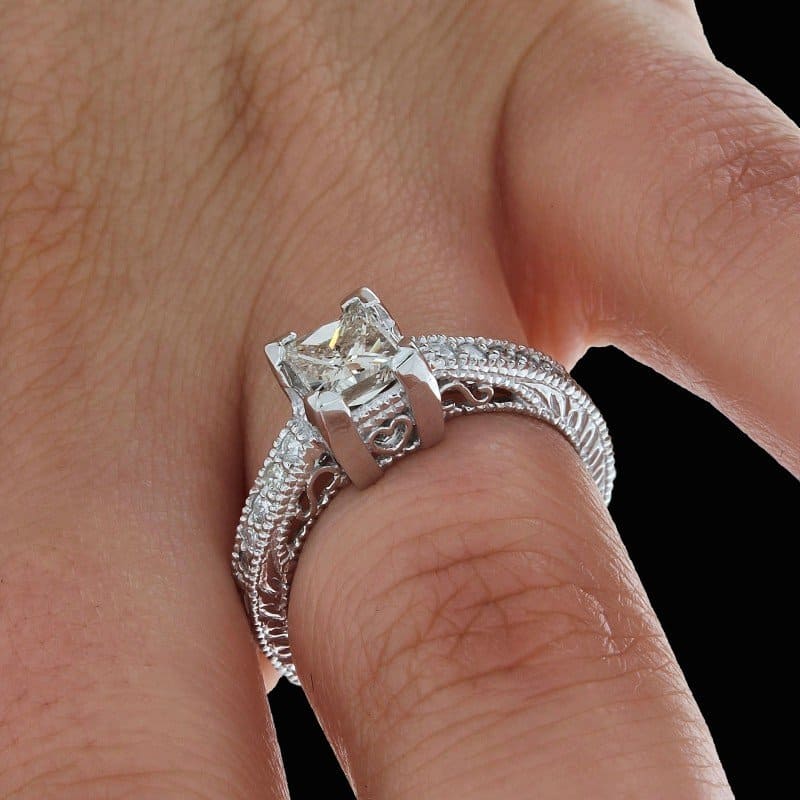
D, E, F – colorless
G, H, I, J – near colorless
K, L, M – faint color
N, O, P, Q, R – very light color
S, T, U, V, W, X, Y, Z – light color
The ideal diamond for a Princess cut is colorless, so grades D, E, or F – however a nearly colorless grading that’s closer to the completely colorless spectrum, such as G, will also produce desirable results.
Setting
The ideal setting for a Princess Cut diamond is a 4 prong setting. A 4 prong setting is the ideal candidate because it allows for the light to penetrate the diamond and, thus, maximizes the brilliance of the ring itself.
For smaller princess cut stones, a channel setting is highly popular. The name leaves very little room for mystery! A channel setting is one in which the diamond is itself set in empty channels within the band.
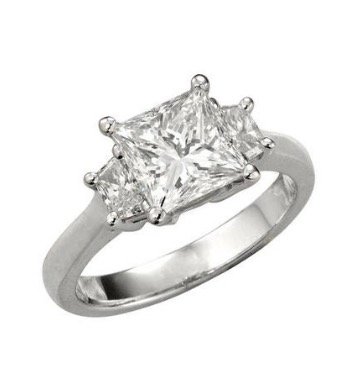
Recap Plus Some
Let’s summarize – a princess cut is a less expensive but equally beautiful when compared against its brilliant round cut competitor, it should not have under 59 facets, it is a forgiving cut that can maximize the imperfections of an imperfect stone, it plays well with gemstones, the corners of the cut are delicate so make sure to get a setting that protects them and/or get them chamfered, and its ideal settings are 4 prong and channel. Whew.
But wait – don’t run to your nearest jeweler quite yet. Before you run out your door, here are a few additional tid bits to keep in mind:
1. If your Princess cut stone is a diamond, deal only with reputable jewelers that will provide IGA certification.
2. If you’re buying a used or antique diamond studded ring, don’t listen to number one. The IGA hasn’t been around forever and diamonds have. Instead, in the instances of antique or used diamonds, ask for a certificate of authenticity or professional appraisal of the diamond you’re buying.
3. If a colored, or colorless, gemstone is you’re thing, we’re into it. Check out our extensive gemstone directory for ways to ensure your are purchasing the best quality authentic gemstone for your ring.
4. It never hurts to get a second opinion – if you’re confident in your purchase, this isn’t necessary, but if you’re like us and like play it safe, take your purchase to a professional jeweler or gemologist for a second opinion as to the quality of your stone.
5. You’re getting married! This should be the most rewarding and enjoyable experience in your life to date – while we absolutely promote the idea that knowledge is important, and that you should be well informed, we also want you to remember not to lose sight of your excitement and joy, so go on, go shopping for your engagement or wedding ring and don’t forget to have fun with it!
Recommended Reads:
- 5 Choices for Cushion Cut Engagement Rings – She’ll Love the Vintage Halo Design
- 5 Traditional to Non-Traditional Brilliant Round Cut Solitaires
- Emerald Cut Diamond Engagement And Wedding Ring Designs
- Radiant Cut Cubic Zirconia (CZ) Engagement Rings for Men
- Radiant Cut Cubic Zirconia (CZ) Engagement Rings for Women
- About The Princess Cut – General Information
